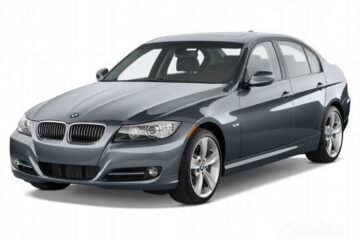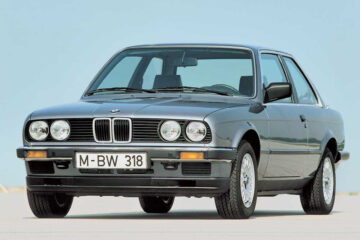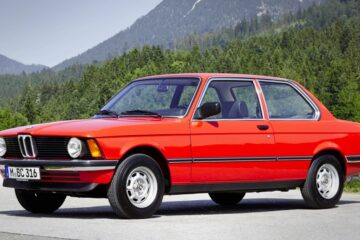The general public saw the sixth generation of cars in the fall of 2011. BMW 3 series F30 cars were presented in Munich. What is interesting, the cars of the fifth generation E90 were successfully sold, and there was no reason to remove them from the assembly line. However, the Bavarian manufacturer, adhering to the laws of marketing, releases new models every 4-5 years, and after 2-3 years, the car either undergoes restyling or a small facelift. Therefore, at the end of winter 2012, sales of 6th generation cars, BMW 3 series F30 began. It should be noted here that the 3-series BMW was hugely popular in the automobile market. 12 million (!) cars of all generations were sold.
At the beginning, only sedans were sold. A little later, sales of station wagons (F31) and extended versions (F35 for China) began. In 2013, the Gran Turismo model (F34) appeared. It was a kind of hybrid of a sedan with a station wagon, having a sloping roof. Then coupe, two-door (F32) and four-door (F36), as well as a convertible (F33) were released.
Appearance
Let’s make a review of the exterior of BMW F30 in a sedan body. The car has a sporty orientation. This can be judged by the low roof of the body and wide lights located on the stern of the car. In the frontal part of the BMW there are “nostrils”, a bumper equipped with air ducts and fog lights, a sloping hood. Head optics adaptive at BMW F30 has received squinted LED headlights. The sloping roof looks athletic. The stern of the car resembles the rear part of the cars of 5/7 series. In any case, similar LED rear optics is installed on the cars of the 5th series. The car can be retrofitted with BMW F30 performance or M dodger. The design is more beautiful than the E90. This is confirmed by the photo of BMW F30. We should add that the aerodynamics of the body amounted to 0.26 Cx. Many hours of blowing its elements in a wind tunnel had an impact.
The BMW F30 has a slight increase in dimensions. Compared to the E90, it has lengthened by 93, grown by 8, become wider by 42 and increased in wheelbase by 50 mm. As a result, the dimensions of the car amounted to 4.624/2.031/1.429/2.81 meters. But the ground clearance has decreased to 1.4 cm.
Despite the increased dimensions, F30 has become lighter than E90. For example, the 335i modification has lost 40 kg in weight.
Interior
The BMW F30 interior is finished with quality materials. Soft, pleasant plastic and genuine leather or alcantara are used in the trim. Multirole BMW F30 is “dressed” in leather and it is three-spoke. The console looks to the driver’s side. The dashboard of BMW F30 is placed behind it. The instruments are simple, but all the information displayed on the screen is easy to read. On the front torpedo there is a monitor of the multimedia system. There are no claims to it, but what is bad is that it is fixed, i.e., the display cannot be hidden in the torpedo.
Here we note that the OEM BMW F30 monitor can be replaced with the advanced NBT EVO. This is a more advanced system and more complete information can be obtained.
The first-row seats are comfortable and moderately wide, with lateral support. Adjustment of seats is allowed in any directions. Increased dimensions of F30 have led to increase of space in the back (above the head, in legs), but still three passengers will be cramped. The optimum variant is two. On the door handles you can notice inserts of wood/aluminum. Cup holders, located in the center of the cabin, are covered with a plastic compartment. The volume of the luggage compartment has increased by 50 units and amounts to 480 liters.
The interior lighting package is an option.
Interior design – three (more about them in the “Equipment” section) “Line” variants:
- BMW F30 Sport;
- “Modern”;
- “Luxury”.
Equipment
So, let’s find out what BMW F30 is equipped with.
In the Sport Line package, the car owner gets R17 wheels, sport suspension and black color: chrome on the exhaust pipe, exterior mirrors, radiator grille and glossy air intake. The interior comes with sport sills/leather steering wheel with red stripe/chairs with inserts of similar color. Leather upholstery. The trim can be black/aluminum, the instrument panel is backlit in red. The control panel will have chrome rings around the buttons. Exclusive design of the gear lever.
In the Modern Line configuration, the exterior is almost the same. Only on the exhaust pipe with radiator grille there will be chrome not black, but decorative matte. The interior also differs little from Sport Line. The same upholstery, sills, inserts, chrome rings, steering wheel. However, there are a little more bright colors.
Taking the car in Luxury Line design, the owner of F30 will become the owner of the same wheels, chrome exhaust pipe with radiator grille. The interior is the same, but in a richer brown color. The center console is made under chrome. This configuration is the most luxurious and prestigious.
There is one more configuration, M Sport. Here the car is equipped with a sports suspension, lowered by a centimeter. Customers are offered R19 light alloy wheels, color projection monitor, adaptive “cruise” and exclusive body paint, interior and original decorative elements. Having additional equipment received in this package, it is possible to refuse tuning of F30 and create a saloon in individual style.
The F30 2.0 is also fitted with autonomous fuel heating.
Electronics and security
Now let’s talk about the electronic equipment of the BMW F30. The car has everything, i.e., the level of electronics and safety is high. In the “base” we have:
- Airbags in a quantity of 6;
- Anti-fog optics;
- ESP/autoparking/ABS systems;
- Light/rain sensors;
- Climate control for two zones;
- Full electrical package;
- Heated seats;
- Keyless access;
- Audio system with USB/MP3;
- Rearview camera with surround view capability.
The ConnectedDrive integrated multimedia system deserves special mention. It combines a variety of services and technological applications. With their help, passengers can have fun while traveling, and the driver can get the necessary information. For example, data can be displayed on the windshield (!), the system will read road signs online, cruise control will become adaptive, cameras can see at night, and there will be no blind spots.
You can access the internet from your F30. Finally, you can use the recommendations of “BMW-Online” to find the right place in unfamiliar locations.
Engine
Now let’s see what the BMW F30 technical specifications are. On the cars of the 6th generation, turbocharged motors replaced atmospheric engines. In the beginning, F30 models were equipped with several power units. The weakest BMW F30 engines are on the 316d model. Under the hood of this version is placed a unit with a volume of 2 liters and a capacity of 116 hp. However, even this machine can move at a speed of 202 km / h, and “hundredth” reaches in 11 sec. Fuel consumption per 100 km is 4.6/3.5 liters in the city / on the highway. With a full tank, 57 liters, F30 316d is able to overcome 1461 km.
The gasoline counterpart, BMW 316i F30, with a volume of 1.6 liters and 136 hp, can accelerate in 8.9 seconds and gain speed up to 210 km / h, and gasoline consumption per 100 km in the range of 6.8-5.9 liters. Almost similar indicators and at BMW 318i F30 with the engine B38. Only the volume is 1.5 liters and fuel consumption is slightly less. 5.1-5.5 л.
These models have rear-wheel drive only.
On the modification BMW F30 320d there is a 183-horsepower two-liter motor, accelerating the car to “hundred” in 8.5 sec. and consumes 4.1-4.5 liters per 100 km. The maximum speed is 235 km/h. In the EfficientDynamics version, the number of horsepower is reduced to 163 units. The same volume and the same power is also in the gasoline counterpart, the BMW 320i F30. However, acceleration to 100 km / h in this car is a little faster, for 7.3 seconds, and the top speed is 235 km / h. However, fuel consumption in the city / on the highway is 8.2/4.9 liters per 100 km.
A two-liter gasoline unit with 6 cylinders and a power of 245 “horses” is installed on the BMW 328i F30. With its help, acceleration takes 5.9 seconds, and fuel consumption in the city / on the highway is 8.5/4.2 liters per 100 km. The speed limit is 250 km/h. The most powerful gasoline unit (306 hp) with a volume of 3 liters, reaches 100 km/h in 5.5 seconds, reaches the speed mark of 250 km/h and “burns” gasoline in the amount of 10/5.5 liters per 100 km in the city / on the highway. It is equipped with the 335i model.
The most powerful model among diesels is the BMW F30 330d. It is equipped with a 258-horsepower motor with a volume of 3.0 liters. Acceleration to a “hundred” is worse than that of the 335i by only 0.1 sec, but the maximum speed is the same. The work of engines of all modifications is combined with 6-speed “manual” and 8-band “automatic”. Moreover, automatic transmission reduces fuel consumption by 0.3 liters per 100 km, and in 335i – immediately by 0.7!
By the way, in the case of all motors, the “automatic” consumes 0.3 liters less fuel. And of course, it is impossible not to note attention. However, only 6-speed “mechanics” is offered as standard. 8-range “automatic” ZF is an option. To increase power and torque, you can use chip tuning N20 Stage 2.
The front suspension is McPherson, reliable and proven. At the rear – multi-lever. The exhaust standard depends on the modification: Euro 5 or Euro 6.
A BMW F30 with the xDrive drivetrain won’t have the hassle.
Difference between restyling and prerestyling
The BMW F30 was restyled in 2015. Let’s analyze the differences between the restyling and prerestyling. The exterior has received minor changes. Optics became absolutely LED. There are new color solutions and designs of wheel rims. In the design of bumpers designers have introduced elongated horizontal lines to visually make the cars wider and lower. Air ducts received a chrome frame. In the cabin there is a different control unit of climate control, door inserts are chrome. Types of equipment, specified above, remained, but the combination of colors with finishing styles has increased. In addition to rear-wheel drive cars, customers are offered with all-wheel drive (xDrive), equipped with two/three-liter gasoline engines and diesel engines with a volume of 2.0 liters.
BMW 340i is able to develop 326 “horses” and the top car received the LTE communication standard, multimedia with a new navigator.
Problems
At the end a little bit about problems. Even reliable cars have their problems. For example, the car eats oil. This usually happens when the turbine is replaced. The main reason is wear of the piston rings.
A common problem is that the BMW jerks when accelerating. It is necessary to change the cylinder coils not to use low-quality fuel. Finally, squeaking. Doors, rear spring, hinges, steering wheel can squeak. The reasons are many. It is better to contact the service. It is recommended to do this and when displaying the message fog lights. Because here, too, there are a lot of options. It is necessary to perform diagnostics and contact an electrician, so that he examined the “Bavarian” on the spot.
Generations and configurations
Sedan 6 generation – restyling
06.2015 – present.
| 318i MT | B38B15 | 1.5l | 136 hp |
| 318i AT | B38B15 | 1.5L | 136 hp |
| 320i MT xDrive | B48B20 | 2.0L | 184 hp |
| 320i MT Sport | B48B20 | 2.0L | 184 hp |
| 320i MT | B48B20 | 2.0L | 184 hp |
| 320i AT xDrive SE | B48B20 | 2.0L | 184 hp |
| 320i AT xDrive 100 Years Edition | B48B20 | 2.0L | 184 hp |
| 320i AT xDrive | B48B20 | 2.0L | 184 hp |
| 320i AT xDrive Luxury Line | B48B20 | 2.0L | 184 hp |
| 320i AT xDrive Sport Line | B48B20 | 2.0L | 184 hp |
| 320i AT xDrive M Sport | B48B20 | 2.0L | 184 hp |
| 320i AT SE | B48B20 | 2.0L | 184 hp |
| 320i AT Sport | B48B20 | 2.0L | 184 hp |
| 320i AT | B48B20 | 2.0L | 184 hp |
| 330i AT xDrive | B48B20 | 2.0L | 252 hp |
| 320d AT xDrive SE | B47D20 | 2.0L | 190 hp |
| 320d AT xDrive 100 Years Edition | B47D20 | 2.0L | 190 hp |
| 320d AT xDrive | B47D20 | 2.0L | 190 hp |
| 320d AT xDrive Luxury Line | B47D20 | 2.0L | 190 hp |
| 320d AT xDrive Sport Line | B47D20 | 2.0L | 190 hp |
| 320d AT xDrive Luxury Line | B47D20 | 2.0L | 190 hp |
| 320d AT xDrive Sport Line | B47D20 | 2.0L | 190 hp |
| 320d AT M Sport | B47D20 | 2.0L | 190 hp |
| 320d AT | B47D20 | 2.0L | 190 hp |
| 340i MT xDrive | B58B30 | 3.0L | 326 hp |
| 340i AT xDrive | B58B30 | 3.0L | 326 hp |
Station wagon 6th generation
05.2012 – 10.2015
| 320i MT xDrive | N20B20 | 2.0L | 184 hp |
| 320i MT | N20B20 | 2.0L | 184 hp |
| 320i AT xDrive | N20B20 | 2.0L | 184 hp |
| 320i AT xDrive | N20B20 | 2.0L | 184 hp |
| 320i AT | N20B20 | 2.0L | 184 hp |
| 328i MT xDrive | N20B20 | 2.0L | 245 hp |
| 328i MT | N20B20 | 2.0L | 245 hp |
| 328i AT xDrive | N20B20 | 2.0L | 245 hp |
| 328i AT xDrive | N20B20 | 2.0L | 245 hp |
| 328i AT | N20B20 | 2.0L | 245 hp |
| 320d AT xDrive | N47D20 | 2.0L | 184 hp |
| 320d AT | N47D20 | 2.0L | 184 hp |
Sedan 6th generation
10.2011 – 08.2015
| 316i MT | N13B16 | 1.6L | 136 hp |
| 316i AT Special Edition | N13B16 | 1.6L | 136 hp |
| 316i AT | N13B16 | 1.6L | 136 hp |
| 320i MT xDrive | N20B20 | 2.0L | 184 hp |
| 320i MT | N20B20 | 2.0L | 184 hp |
| 320i AT xDrive M Sport | N20B20 | 2.0L | 184 hp |
| 320i AT xDrive | N20B20 | 2.0L | 184 hp |
| 320i AT Special Edition | N20B20 | 2.0L | 184 hp |
| 320i AT | N20B20 | 2.0L | 184 hp |
| 328i MT xDrive | N20B20 | 2.0L | 245 hp |
| 328i MT | N20B20 | 2.0L | 245 hp |
| 328i AT xDrive Luxury Line | N20B20 | 2.0L | 245 hp |
| 328i AT xDrive | N20B20 | 2.0L | 245 hp |
| 328i AT Luxury Line | N20B20 | 2.0L | 245 hp |
| 328i AT | N20B20 | 2.0L | 245 hp |
| 320d AT xDrive Modern Line | N47D20 | 2.0L | 184 hp |
| 320d AT xDrive Luxury Line | N47D20 | 2.0L | 184 hp |
| 320d AT xDrive Sport Line | N47D20 | 2.0L | 184 hp |
| 320d AT xDrive | N47D20 | 2.0L | 184 hp |
| 320d AT | N47D20 | 2.0L | 184 hp |
| 335i MT xDrive | N55B30 | 3.0L | 306 hp |
| 335i MT | N55B30 | 3.0L | 306 hp |
| 335i AT xDrive | N55B30 | 3.0L | 306 hp |
| 335i AT | N55B30 | 3.0L | 306 hp |



0 Comments